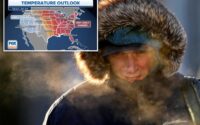Easter Island statue discovered as drought conditions worsen
A new moai was found on Easter Island in the bed of a volcano crater lake, thanks to severe drought conditions in the area.
The Pacific island, located roughly 2,175 miles west of the Chilean coast, is famed for its more than 900 stone figures, known as moai. The monolithic moai were carved out of volcanic ash by the Rapa Nui people as far back as 1100 A.D.
The newly found moai was discovered by volunteers from three Chilean universities, who were working on a project to help restore the marshland in the Rano Raruku volcano, Agence France-Presse reported.
Ninoska Avareipua Huki Cuadros, director of the Ma’u Henua Indigenous community that manages the Rapa Nui nNtional park, where the volcano is located, told AFP the lake where the moai was found had begun drying up in 2018.
“The interesting thing is that, for at least the last 200 or 300 years, the laguna was three meters deep, meaning no human being could have left the moai there in that time,” Huki said.

The recently discovered moai measures just five feet tall and was found by the researchers on its side, looking toward the sky.
The tallest moai measures 33 feet, and on average, the statues weigh between three to five tons, Terry Hunt, professor of archeology at the University of Arizona, told Good Morning America.
“The moai are important because they really represent the history of the Rapa Nui people,” Hunt said. “They were the islanders’ deified ancestors. They’re iconic worldwide, and they really represent the fantastic archeological heritage of this island.”

Jo Anne Van Tilburg, an archeologist and the director of the Easter Island Statue Project, told Fox Weather that years of harsh climate conditions, including drought and grass fires, led to the lake drying up — and the latest discovery.
“Right now, the issue is for them to put a conservation team together so that they can stabilize the statue because its exposure can become problematic for it,” Van Tilburg said.
Several moai in Rapa Nui national park were charred in October and suffered irreparable damage after a forest fire ripped through the area.

Given the current weather conditions and likelihood of future excavations, more moai discoveries are all but certain, Van Tilburg said.
“We finished a lot of mapping and documentation of the quarry between 2018 and 2019, and what we found was that there was a lot more evidence of more quarrying on the outside than we had originally thought,” Van Tilburg stated. “One hundred percent they’ll be more discoveries like this.”


